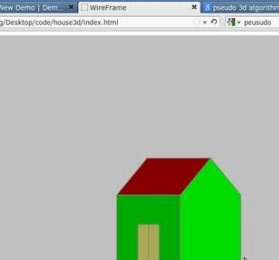VB.Net中文教程(13) Whole-Part关系_.NET教程_编程技术
2013-12-20 14:23:10
[小 大]
已经帮助:人解决问题
教程|中文
主题: Whole-Part关系?????????? 内容 ??????????
v 1. 对象Whole-Part关系
v 2. 组合/部分关系
v 3. 包含者/内容关系
v 4. 集合/成员关系
1. 对象Whole-Part关系
类别继承(Class inheritance)和对象组合(Object composition)是软件再使用(Reuse)的两大法宝。类别继承就是建立父、子类别之关系�例如�「学生」可分为「大学生」、「中学生」和「小学生」三类别�其继承关系图标如下�
图1、 以UML表达类别继承
对象组合的目的是�创造「复合对象」(Composite object)�例如�医院内含医师和护士等�其组合关系图标如下�
图2、 以UML表达对象组合
继承与组合两大法宝能联合使用�以组织庞大的软件系统。例如�汽车分为客车、卡车、轿车等子类别�而且汽车内含引擎、车体、轮胎等零件�则此汽车系统图标如下图3和图4�
图3、 汽车的类别继承体系
图4、 汽车的对象组合关系
本节里�将进一步分析与说明对象组合方法。尤顿(Yourdon) 认为�常见组合关系有三�
1) 组合�部分(Assembly-parts)关系。
2) 包含�内容(Container-contents)关系。
3) 集合�成员(Collection-members)关系。
2. 组合/部分关系
组合/部分关系�常称为APO(A part of)关系�例如�汽车是「组合」�其内含各零件是「部分」。门是房子的一部分�所以房子是「组合」�门是「部分」�此外�窗子也是房子的「部分」。这房子与门窗之关系�图标如下�
图5、 房子的对象组合关系
以VB表达如下�
'ex01.bas
Imports System.ComponentModel
Imports System.Drawing
Imports System.WinForms
'---------------------------------------------------------------------------------
Class House
Class Door
Public size As Double
Public Sub New(ByVal s As Double)
size = s
End Sub
End Class
Class Window
Public size As Double
Public Sub New(ByVal s As Double)
size = s
End Sub
End Class
Private dr As Door
Private win As Window
Public Sub New()
dr = New Door(50)
win = New Window(100)
End Sub
Public Sub Show()
Messagebox.Show("Door: " + str(dr.size) + " Win: " + str(win.size))
End Sub
End Class
'---------------------------------------------------------------------------------------------------
Public Class Form1
Inherits System.WinForms.Form
Public Sub New()
MyBase.New()
Form1 = Me
'This call is required by the Win Form Designer.
InitializeComponent()
'TODO: Add any initialization after the InitializeComponent() call
End Sub
'Form overrides dispose to clean up the component list.
Public Overrides Sub Dispose()
MyBase.Dispose()
components.Dispose()
End Sub
#Region " Windows Form Designer generated code "
......
#End Region
Protected Sub Form1_Click(ByVal sender As Object, ByVal
e As System.EventArgs)
Dim h As New House()
h.Show()
End Sub
End Class
以此程序输出如下�
Door: 50 Win: 100
House 之对象诞生后�立即诞生内含之Door对象和Window对象。例如�宣告指令──
Dim h As New House()
此时�h 对象诞生了�其内含之dr 和win对象亦诞生了。
此h 通称为「组合对象」(Composite object)�而dr 和win 则称为「部分对象」(Component object)。这种关系具有一项特色�组合对象与部分对象的寿命应该是一致的。
在逻辑(Logical)意义上,这House 结构中�门和窗随着房子而具有「生死与共」之亲蜜关系,也就是寿命一致。在计算机实体(Physical)表达时,House 之对象并不「真正」包含Door及Window之对象�只是利用两个参考指向它们。所以上图也可想象如下:
上述两种实体结构皆表达了「组合/部分」关系。请再看个例子:
'ex02.bas
Imports System.ComponentModel
Imports System.Drawing
Imports System.WinForms
'----------------------------------------------------
Class Person
Private p_name As String
Private p_age As Integer
Public Sub New(ByVal na As String, ByVal a As Integer)
p_name = na
p_age = a
End Sub
Public Function isEqual(ByVal obj As Person) As Integer
Dim k As Integer = 0
If Me.p_name = obj.p_name Then
k = 1
End If
isEqual = k
End Function
Public Sub Show()
Messagebox.Show(Me.p_name + ", " + str(Me.p_age))
End Sub
End Class
'---------------------------------------------------------------------------------
Public Class Form1
Inherits System.WinForms.Form
Public Sub New()
MyBase.New()
Form1 = Me
'This call is required by the Win Form Designer.
InitializeComponent()
'TODO: Add any initialization after the InitializeComponent() call
End Sub
'Form overrides dispose to clean up the component list.
Public Overrides Sub Dispose()
MyBase.Dispose()
components.Dispose()
End Sub
#Region " Windows Form Designer generated code "
.........
#End Region
Protected Sub Form1_Click(ByVal sender As Object,
ByVal e As System.EventArgs)
Dim a As New Person("Alvin", 35)
Dim b As New Person("David", 25)
a.Show()
b.Show()
Messagebox.Show(str(a.isEqual(b)))
Messagebox.Show(str(b.isEqual(New Person("David", 32))))
End Sub
End Class
此程序输出�
Alvin, 35
David, 25
0
1
「组合」对象之建构者New()程序诞生「部分」对象。此a 、b 两对象之内容为�
在isEqual()程序里,两个对象拿其p_name 值来比较。例如�a.p_name 值是"Alvin" �而b.p_name 值是"David" �所以a.isEqual(b)表达式之值为0 (False)。
3. 包含者/内容关系
上节的House 结构中�门和窗随着房子而具有「生死与共」之亲蜜关系。然而�日常生活中�常见类似但并不如此亲蜜的情形。例如�飞行员坐于飞机驾驶仓内开飞机�司机在汽车内驾驶汽车�客人乘座于巴士内等等。司机不是汽车的零件�客人亦非巴士之组件�所以汽车与司机之间并非「组合/部分」关系�然而�汽车的确包含着司机�因之称为「包含者/内容」(Container-contents)关系。
司机和汽车为独立之对象�不像引擎一直包含于汽车内�于驾驶汽车时�司机才被包含于汽车内。显然地�司机与汽车之寿命不一样长。「包含者/内容」关系是一种特殊的组合结构�其图标方法与「组合/部分」关系相同。例如�
此图表达了�
◎ 汽车与引擎之间为「组合/部分」关系。
◎ 汽车与司机之间为「包含者/内容」关系。
以VB表达如下�
'ex03.bas
Imports System.ComponentModel
Imports System.Drawing
Imports System.WinForms
'----------------------------------------------------
Class Driver
Private name As String
Public Sub New(ByVal na As String)
name = na
End Sub
Public Sub Show()
MessageBox.Show("Driver: " + name)
End Sub
End Class
Class Car
Class Engine
Public model As String
Public Sub New(ByVal mdl As String)
model = mdl
End Sub
End Class
Private e As Engine
Private dr As Driver
Public Sub New()
e = New Engine("Honda")
End Sub
Public Sub assignTo(ByVal d As Driver)
dr = d
End Sub
Public Sub Show()
MessageBox.Show("Engine: " + e.model)
dr.Show()
End Sub
End Class
'----------------------------------------------------
Public Class Form1
Inherits System.WinForms.Form
Public Sub New()
MyBase.New()
Form1 = Me
'This call is required by the Win Form Designer.
InitializeComponent()
'TODO: Add any initialization after the InitializeComponent() call
End Sub
'Form overrides dispose to clean up the component list.
Public Overrides Sub Dispose()
MyBase.Dispose()
components.Dispose()
End Sub
#Region " Windows Form Designer generated code "
.......
#End Region
Protected Sub Form1_Click(ByVal sender As Object, ByVal e As System.EventArgs)
Dim civic As New Car()
Dim d1 As New Driver("Wang")
Dim d2 As New Driver("Kao")
civic.assignTo(d1)
civic.Show()
civic.assignTo(d2)
civic.Show()
End Sub
End Class
此程序输出�
Model: Honda
Driver: Wang
Model: Honda
Model" Kao
Car之对象诞生后�也诞生Engine之对象e �同时立即指定司机�如下指令�
Dim civic As New Car()
Dim d1 As New Driver("Wang")
.....
civic.assignTo(d1)
.....
日常生活中的常见情况�汽车对象诞生时�不须立即指定司机对象。例如�汽车出厂时或闲置时并无司机�且汽车经常更换司机。此情形下�应先诞生civic对象和d1对象,如下:
此时,未立即指定司机�而必要时才以assignTo()程序指定司机。例如,将d1指定给civic对象�就令civic内之参考变量dr指向d1 对象,如下:
上述程序里,d1、d2及civic 对象之间�谁先诞生并无关紧要�各独立存在。指令──civic.assignTo(d1) 将d1司机指定给civic 对象�另一指令──civic.assignTo(d2)表示�改由d2担任civic 之司机。
此Car 类别以参考变量e来指向Engine之对象。现在�兹拿上节的Person类别做为例子�如果某人(Person 之对象)结婚了�就有配偶�反之尚未结婚时�则无配偶。此时�应将Person类别之定义修改如下�以表达这种「配偶」关系�
'ex04.bas
Imports System.ComponentModel
Imports System.Drawing
Imports System.WinForms
'----------------------------------------------------
Class Person
Private p_name As String
Private p_age As Integer
Private p_spouse As Person
Public Sub New(ByVal na As String, ByVal a As Integer)
p_name = na
p_age = a
End Sub
Public Sub spouse(ByVal sp As Person)
p_spouse = sp
sp.p_spouse = Me
End Sub
Public Sub Show()
Messagebox.Show(Me.p_name + ", " + str(Me.p_age)
+ ", sp: " + Me.p_spouse.p_name)
End Sub
End Class
'----------------------------------------------------
Public Class Form1
Inherits System.WinForms.Form
Public Sub New()
MyBase.New()
Form1 = Me
'This call is required by the Win Form Designer.
InitializeComponent()
'TODO: Add any initialization after the InitializeComponent() call
End Sub
'Form overrides dispose to clean up the component list.
Public Overrides Sub Dispose()
MyBase.Dispose()
components.Dispose()
End Sub
#Region " Windows Form Designer generated code "
......
#End Region
Protected Sub Form1_Click(ByVal sender As Object, ByVal
e As System.EventArgs)
Dim x As New Person("David", 32)
Dim y As New Person("Hellen", 24)
x.spouse(y)
x.Show()
y.Show()
End Sub
End Class
此程序输出�
David, 32, sp: Hellen
Hellen, 24, sp: David
资料成员p_spouse指向配偶�而配偶亦为Person之对象。所以p_spouse之型态应为Person。一个人刚诞生时并无配偶�到结婚时才有配偶�所以藉spouce()来建立配偶关系。对象x 与y 结婚之后�互为对方之配偶。所以x.p_spouse指向y �而y.p_spouse则指向x 。此时�x 和y 之内容如下�
于是这Person类别表达了「婚姻」关系。
4. 集合/成员关系
集合意谓着「团体」(Group) �由其成员(Member)组成的群体。例如�学校里的社团内有团员�公司的销售部含有推销人员。这团体并不像汽车实际包含着司机�而只是其成员之集合而已。这情形�统称为「集合/成员」(Collection-members)关系。
有趣的是�在企业活动中�人们规划的方案�含许多小方案�则大方案是由小方案所组成。例如�东北亚旅行团的行程表包括在日本的观光行程、在韩国的观光行程和在香港的观光行程。这总行程表图标如下�
总行程是次行程(或称段行程)之集合�这是「集合/成员」关系。
此外�棒球队是由经理、教练和球员组成�订单中含若干产品项目�皆为集合/成员关系。实际写程序时�不需明确划分「包含者/内容」和「集合/成员」两种关系。其原因是�集合与成员之间亦可互为独立�不具「生死与共」之亲蜜关系�例如�「香港观光行程」是独立存在的�它既可含于东北亚总行程中�又可含于东南亚旅行团的总行程中。因之�「集合/成员」关系是一种特殊的「组合」(Composition) 结构。
兹拿上节Person类别做为例子�如果Person之对象会加入Club(俱乐部)成为俱乐部的会员�则Club与Person之关系为「集合/成员」关系。兹定义Club类别如下�
'ex05.bas
Imports System.ComponentModel
Imports System.Drawing
Imports System.WinForms
Imports System.Collections
'----------------------------------------------------
Class Person
Private p_name As String
Private p_age As Integer
Public Sub New(ByVal na As String, ByVal a As Integer)
p_name = na
p_age = a
End Sub
Public Sub display()
Messagebox.Show(Me.p_name + ", " + str(Me.p_age))
End Sub
End Class
Class Club
Private c_name As String
Private pa As ArrayList
Public Sub New(ByVal na As String)
c_name = na
pa = New ArrayList()
End Sub
Public Sub join(ByVal p As Person)
pa.Add(p)
End Sub
Public Sub display()
Messagebox.Show("Club: " + Me.c_name + " has member:")
Dim p As Person
For Each p In pa
p.display()
Next
End Sub
End Class
'-------------------------------------------------------------------------------
Public Class Form1
Inherits System.WinForms.Form
Public Sub New()
MyBase.New()
Form1 = Me
'This call is required by the Win Form Designer.
InitializeComponent()
'TODO: Add any initialization after the InitializeComponent() call
End Sub
'Form overrides dispose to clean up the component list.
Public Overrides Sub Dispose()
MyBase.Dispose()
components.Dispose()
End Sub
#Region " Windows Form Designer generated code "
......
#End Region
Protected Sub Form1_Click(ByVal sender As Object, ByVal e As System.EventArgs)
Dim x As New Club("sogo")
Dim a As New Person("Alvin", 32)
Dim b As New Person("Judy", 28)
x.join(a)
x.join(b)
x.display()
End Sub
End Class
此程序输出�
Club: sogo has member:
Alvin, 32
Judy, 28
c_name 指向Strclass之对象�这对象内含俱乐部之名称。pa指向ArrayList之对象�这对象可包含许多会员(Person)对象。join()程序将Person之对象存入pa所指的ArrayList对象中。
Club之对象含ArrayList之对象�此集合对象(Collections)含有Person之对象�表达了「集合/成员」关系。例如�x 对象内含a 和b 对象。
此图表示�"sogo"俱乐部共有"Alvin" 和"Judy"两个会员�亦即x 是「集合」�而a 和b 是「成员」(Member)。
值得注意�这软件是利用已有类别──Strclass及Integer组合成应用类别──Person。再利用Person类别及ArrayList 类别组合成更复杂之应用类别──Club。未来�可利用Club及其它类别构筑更大的应用类别�依此类推�便能创造庞大又可靠的软件了。例如:
'ex06.bas
Imports System.ComponentModel
Imports System.Drawing
Imports System.WinForms
Imports System.Collections
'----------------------------------------------------
Class Person
Private p_name As String
Private p_age As Integer
Public Sub New(ByVal na As String, ByVal a As Integer)
p_name = na
p_age = a
End Sub
Public Sub display()
Messagebox.Show(Me.p_name + ", " + str(Me.p_age))
End Sub
End Class
Class Club
Private c_name As String
Private pa As ArrayList
Public Sub New(ByVal na As String)
c_name = na
pa = New ArrayList()
End Sub
Public Sub join(ByVal p As Person)
pa.Add(p)
End Sub
Public Sub display()
Messagebox.Show("Club: " + Me.c_name + " has member:")
Dim p As Person
For Each p In pa
p.display()
Next
End Sub
End Class
'----------------------------------------------------
Public Class Form1
Inherits System.WinForms.Form
Public Sub New()
MyBase.New()
Form1 = Me
'This call is required by the Win Form Designer.
InitializeComponent()
'TODO: Add any initialization after the InitializeComponent() call
End Sub
'Form overrides dispose to clean up the component list.
Public Overrides Sub Dispose()
MyBase.Dispose()
components.Dispose()
End Sub
#Region " Windows Form Designer generated code "
......
#End Region
Protected Sub Form1_Click(ByVal sender As Object, ByVal e As System.EventArgs)
Dim x(2) As Club
x(0) = New Club("sogo")
x(1) = New Club("gold")
Dim a As New Person("Alvin", 32)
Dim b As New Person("Judy", 28)
Dim c As New Person("Bob", 38)
x(0).join(a)
x(0).join(b)
x(1).join(b)
x(1).join(c)
x(0).display()
x(1).display()
End Sub
End Class
此程序输出:
Club: sogo has member:
Alvin, 32
Judy, 28
Club: gold has member:
Judy, 28
Bob, 38
组合对象x 含"sogo"及"gold"两俱乐部�其中"gold"俱乐部拥有两个会员──"Alvin" 及"Judy"�而"sogo"俱乐部拥有两位会员──"Judy"及"Bob" 。x(0)代表"sogo"俱乐部�s(1)代表"gold"俱乐部�所以指令── s(0).join( a ) 表示a 加入"gold"俱乐部�成为其会员。n
(责任编辑:)
友情链接:联系人:QQ370158739




